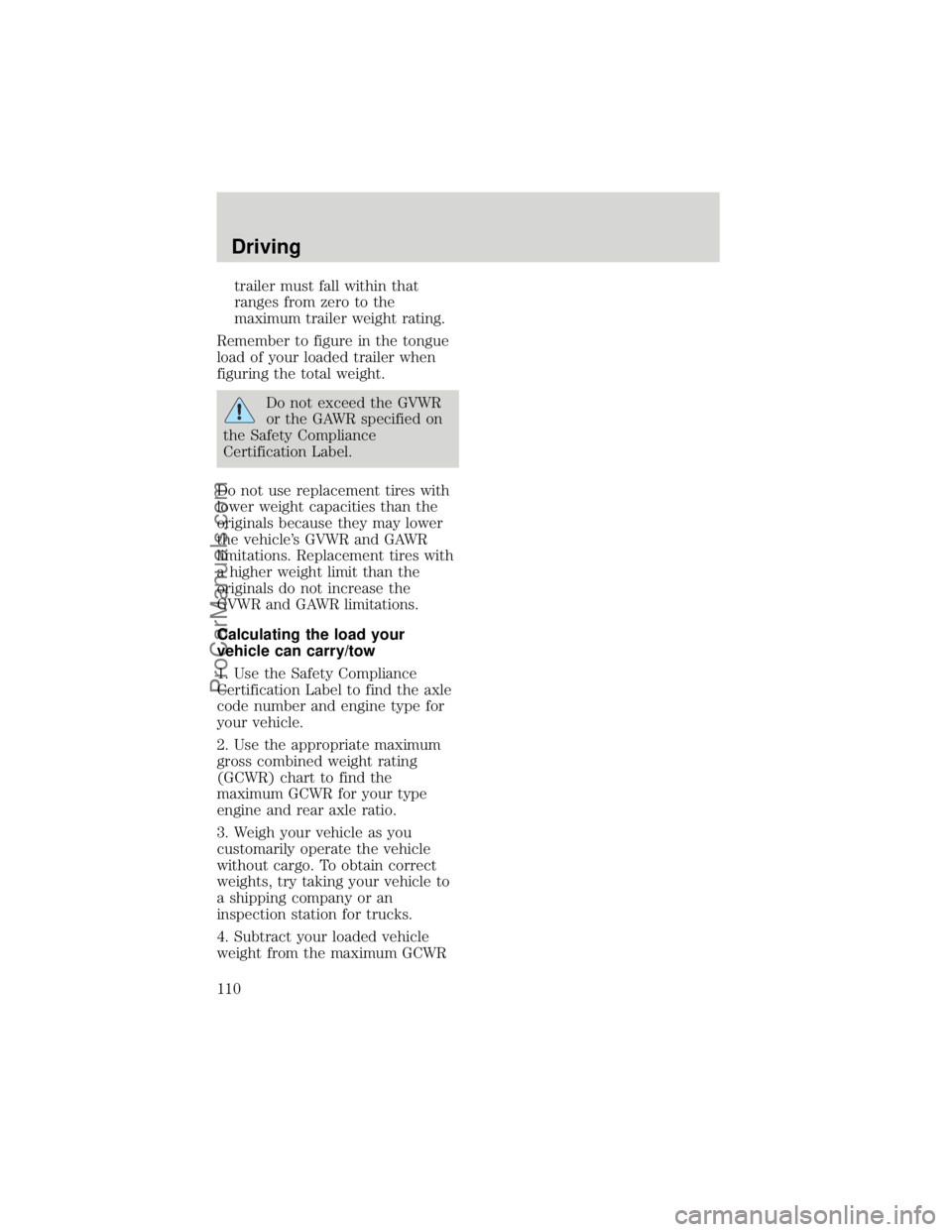Page 70 of 219

A belt-positioning booster should
be used if the shoulder belt rests
in front of the child's face or neck,
or if the lap belt does not fit
snugly on both thighs, or if the
thighs are too short to let the child
sit all the way back on the seat
cushion when the lower legs hang
over the edge of the seat cushion.
You may wish to discuss the
special needs of your child with
your pediatrician.
SAFETY SEATS FOR CHILDREN
Child and infant or child safety
seats
Use a safety seat that is
recommended for the size and
weight of the child. Carefully
follow all of the manufacturer's
instructions with the safety seat
you put in your vehicle. If you do
not install and use the safety seat
properly, the child may be injured
in a sudden stop or collision.
When installing a child safety seat:
²Use the correct safety belt
buckle for that seating position.
²Make sure the tongue is
securely fastened in the buckle.
²Keep the buckle release button
pointing up and away from the
safety seat, with the tongue
between the child seat and the
release button, to prevent
accidental unbuckling.
Seating and safety restraints
70
ProCarManuals.com
Page 108 of 219

Avoid sudden applications of
power and quick changes of
direction on snow and ice. Apply
the accelerator slowly and steadily
when starting from a full stop.
When braking, apply the brakes as
you normally would. In order to
allow the anti-lock brake system
(ABS) to operate properly, keep
steady pressure on the brake
pedal.
Allow more stopping distance and
drive slower than usual. Consider
using one of the lower gears.
VEHICLE LOADING
Before loading a vehicle, familiarize
yourself with the following terms:
²Base Curb Weight: Weight of
the vehicle including any
standard equipment, fluids,
lubricants, etc. It does not
include passengers or
aftermarket equipment.
²Payload: Combined maximum
allowable weight of cargo,
passengers and optional
equipment. The payload equals
the gross vehicle weight rating
minus base curb weight.
²GVW (Gross Vehicle Weight):
Base curb weight plus payload
weight. The GVW is not a limit
or a specification.
²GVWR (Gross Vehicle Weight
Rating): Maximum total weight
of the base vehicle, passengers,
optional equipment and cargo.
The GVWR is specific to each
Driving
108
ProCarManuals.com
Page 109 of 219

vehicle and is listed on the
Safety Compliance Label on the
driver's door pillar.
²GAWR (Gross Axle Weight
Rating): Carrying capacity for
each axle system. The GAWR is
specific to each vehicle and is
listed on the Safety Compliance
Label on the driver's door pillar.
²GCWR (Gross Combined
Weight Rating): Maximum
combined weight of towing
vehicle (including passengers
and cargo) and the trailer. The
GCWR indicates the maximum
loaded weight that the vehicle is
allowed to tow.
²Maximum Trailer Weight
Rating: Maximum weight of a
trailer the vehicle is permitted
to tow. The maximum trailer
weight rating equals the vehicle
curb weight for each
engine/transmission
combination, any required
option weight for trailer towing
and the weight of the driver
from the GCWR for the towing
vehicle.
²Maximum Trailer Weight:
maximum weight of a trailer the
loaded vehicle (including
passengers and cargo) is
permitted to tow. It is
determined by subtracting the
weight of the loaded trailer
towing vehicle from the GCWR
for the towing vehicle.
²Trailer Weight Range:
Specified weight range that the
Driving
109
ProCarManuals.com
Page 110 of 219

trailer must fall within that
ranges from zero to the
maximum trailer weight rating.
Remember to figure in the tongue
load of your loaded trailer when
figuring the total weight.
Do not exceed the GVWR
or the GAWR specified on
the Safety Compliance
Certification Label.
Do not use replacement tires with
lower weight capacities than the
originals because they may lower
the vehicle's GVWR and GAWR
limitations. Replacement tires with
a higher weight limit than the
originals do not increase the
GVWR and GAWR limitations.
Calculating the load your
vehicle can carry/tow
1. Use the Safety Compliance
Certification Label to find the axle
code number and engine type for
your vehicle.
2. Use the appropriate maximum
gross combined weight rating
(GCWR) chart to find the
maximum GCWR for your type
engine and rear axle ratio.
3. Weigh your vehicle as you
customarily operate the vehicle
without cargo. To obtain correct
weights, try taking your vehicle to
a shipping company or an
inspection station for trucks.
4. Subtract your loaded vehicle
weight from the maximum GCWR
Driving
110
ProCarManuals.com
Page 111 of 219
on the following charts. This is the
maximum trailer weight your
vehicle can tow and must fall
below the maximum shown under
maximum trailer weight on the
chart.
DRIVING THROUGH WATER
Do not drive quickly through
standing water, especially if the
depth is unknown. Traction or
brake capability may be limited
and if the ignition system gets wet,
your engine may stall. Water may
also enter your engine's air intake
and severely damage your engine.
If driving through deep or standing
water is unavoidable, proceed very
slowly. Never drive through water
that is higher than the bottom of
the hubs (truck)/wheel rims (car).
Once through the water, always try
the brakes. Wet brakes do not stop
the vehicle as effectively as dry
brakes. Drying can be improved by
moving your vehicle slowly while
applying light pressure on the
brake pedal.
Driving
111
ProCarManuals.com
Page 112 of 219
TOWING A TRAILER
Your vehicle may tow a class I, II
or III trailer provided the
maximum trailer weight is less
than or equal to the maximum
trailer weight listed for your engine
and rear axle ratio on the following
charts.
Your vehicle's load capacity is
designated by weight, not by
volume, so you cannot necessarily
use all available space when
loading a vehicle.
Towing a trailer places an
additional load on your vehicle's
engine, transmission, axle, brakes,
tires and suspension. Inspect these
components carefully after any
towing operation.
Do not exceed the GVWR
or the GAWR specified on
the Safety Compliance
Certification Label.
Driving
112
ProCarManuals.com
Page 113 of 219
Towing trailers beyond the
maximum recommended
gross trailer weight could result
in engine damage,
transmission/axle damage,
structural damage, loss of
control, and personal injury.
Trailer towing tables
F-150 4x2 with automatic
transmission
Engine Rear axle ratio Maximum
GCWR-kg
(lbs.)Maximum
trailer
weight-kg
(lbs.)
Regular Cab
4.2L 3.08 4 077 (9 000) 2 177 (4 800)
4.2L 3.55 4 530 (10 000) 2 582 (5 800)
4.6L 3.08 4 530 (10 000) 2 582 (5 800)
4.6L 3.55 5 209 (11 500) 3 261 (7 200)
5.4L 3.08 4 983 (11 000) 2 948 (6 500)
5.4L 3.55 5 753 (12 700) 3 268 (8 000)
SuperCab
4.2L 3.08 4 077 (9 000) 2 086 (4 600)
4.2L 3.55 4 530 (10 000) 2 540 (5 600)
4.6L 3.08 4 530 (10 000) 2 491 (5 500)
4.6L 3.55 5 209 (11 500) 3 171 (7 000)
5.4L 3.08 4 983 (11 000) 2 857 (6 300)
5.4L 3.55 4 983 (12 700) 3 628 (8 000)
Driving
113
ProCarManuals.com
Page 114 of 219

F-150 4x2 manual transmission
Engine Rear axle
ratioMaximum
GCWR-kg
(lbs.)Maximum
trailer
weight-kg
(lbs.)Maximum
frontal area
of
trailer-m
(ft)
Regular Cab F-150
4.2L 3.08 2 944 (6 500) 1 041 (2 300) 5.52 (60)
4.2L 3.55 3 533 (7 800) 1 630 (3 600) 5.52 (60)
4.6L 3.08 2 944 (6 500) 997 (2 200) 5.52 (60)
4.6L 3.55 3 533 (7 800) 1 587 (3 500) 5.52 (60)
SuperCab F-150
4.2L 3.08 2 944 (6 500) 951 (2 100) 5.52 (60)
4.2L 3.55 3 533 (7 800) 1 540 (3 400) 5.52 (60)
4.6L 3.08 2 944 (6 500) 907 (2 000) 5.52 (60)
4.6L 3.55 3 533 (7 800) 1496 (3 300) 5.52 (60)
F-150 4x4 automatic
transmission
Engine Rear axle
ratioMaximum
GCWR-kg
(lbs.)Maximum
trailer
weight-kg
(lbs.)Maximum
frontal area
of
trailer-m
(ft)
Regular Cab F-150
4.2L 3.08 4 077 (9 000) 1 995 (4 400) 5.52 (60)
4.2L 3.55 4 530 (10 000) 2 449 (5 400) 5.52 (60)
4.6L 3.08 4 530 (10 000) 2 404 (5 300) 5.52 (60)
4.6L 3.55 5 209 (11 500) 3 084 (6 800) 5.52 (60)
5.4L 3.08 4 983 (11 000) 2 721 (6 000) 5.52 (60)
5.4L 3.55 5 753 (12 700) 3 492 (7 700) 5.52 (60)
SuperCab F-150
4.6L 3.08 4 530 (10 000) 2 313 (5 100) 5.52 (60)
Driving
114
ProCarManuals.com